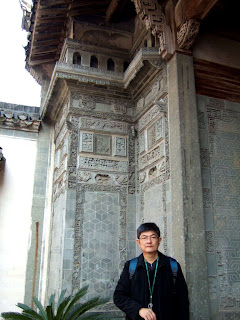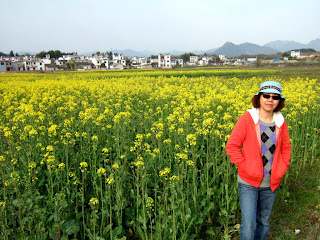
Shexian and Yixian counties of Huangshan City had been established for more than 2000 years, abundant of old residences, archways, clan temples, ancient bridges and pagodas. In this natural history and culture museum of China, Tangyue's memorial archway is as famous and attractive as Tunxi's ancient streets and Yixian's ancient villages. Archway was the highest honor recognized by ancient society in personal conduct and moral especially from officers related family members. There were more than 1000 of them but now only left about 100 over. Shexian, a Town of Arches, has the biggest existing and best preserved complex of archways in Anhui.


Tangye is a scenic little village, 6 km form Shexian Town center and 26km away from Tunxi.


In the main street of Tangyue, there were a complex of seven archways built by Baos Family in honor of merits and virtues of their family members, about 600 years ago.


The arches were standing in order of loyalty, filial piety, chastity and charity.



Among the seven, three were built in Ming Dynasty (1368-1644) and four in Qing Dynasty (1644-1911)


The first one was built in 1420 during the reign of Ming Emperor Yongle and the latest one was completed in 1820 in the reign of Emperor Jiaqing during Qing Dynasty.



Anhui State of Council has included all the seven arches into list of key national cultural protection unit in 1996.


Among the stories, the most acknowledged was the one of filial piety, built in honor of Bao Sheyan and son Bao Shousun. Father and son wanted to sacrifice the life in order to save the other party when they were captured by a Yan general and one of them had to be executed. Their action and love for each other moved the general and finally released both of them. In praise of their filial piety, the court approved the construction of an archway.



Jie Jin San Dong Archway was in praise of a step mother who remained chaste at the age of 29, while raising her stepchild and treated him like her own, after her husband Baowen died. The officials were touched by her deed and erect an archway to honor her in spite of the traditional convention that second wife was not eligible for that.


The Charity archway was built in Qing Dynasty when Bao family contributed big sum of donations to government and public including providing military rations and repaired plus constructed 800 miles river levee to avoid water flood.






Archways at Tangyue are the representatives of Hui's history and culture.




Each archways has an inscription by the sides, telling the stories behind.m3






While Studying the touching story behind each archway, we were absolutely intoxicated by the scenic nature around.


Not a single space was not dyed in yellow with rape seed flower between period in mid March to mid April.











One of its old buildings.



The grounds.


At Bao's Ancestral Temple there is a hexagon archway model. It was said that when an officer was ordered to build an archway, he took months and never reported back to Imperial Palace. The Emperor was so annoyed and told him off that by taking so long period, he should have completed a hexagon archway. The officer immediately seized the opportunity and admitted that he had done a hexagon archway as in those days, no one was allowed to built a hexagon archway except for royal purposes. The hexagon archway built prior to an Emperor's consent is still existing at Shexian.


The history of Bao's family and drawing of some of their famous family members.


There are two Ancestral Temple for Bao's family, Qingyi Tang for women and Dunben Tang for men. Qingyi Tang is particularly significant in studying the patriarchal clan system. It was very rare for women to have privilege to be honored in an ancestral hall.




The ornamental stone carvings of Bao's ancestral Temple hall and some of the wood structure, though they have been restored, still reflects the beautiful architecture of Hui.












Tangyue literally means the shade under two wild pear trees, is an ancient village of 800 years formed since Song Dynasty. Residents in village were descendant of Bao family originated from Imperial officers Bao Hong dated back to nearly 1700 years ago.


Hui styled garden.





The white and violet magnolia flowers in the garden.


The simple transport we took from the main road after a bus ride to enter into Tangyue. It cost about rmb5.00 for a 20 minutes ride, slow and steady.


Violet magnolia fully blossom at the blue mountain foot turned Shexian into a scenic spot for photographers.





Traditional villages with grey roof and white wall could be seen within the town of Shexian.


Yellow rape seed flower carpeted the whole village at this early spring season.


We paid a private driver rmb50.00 for a half day trip to visit all these small villages in Shexian.




















No comments:
Post a Comment